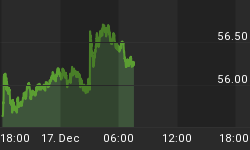We did even more digging, and discovered that this fascinating pattern, the rare Broadening Top, or Megaphone, was not only present at historic tops in 1929, 1957, 1986, and 1987, but also led up to the dramatic decline from 2000 to 2002 by forming over the multi-year period 1998 through 2000, shown below. The question that leaps into my mind after sitting back and staring at all these patterns is, when, in each of these past investment periods, traders and investors found themselves at point e, do you suppose they realized what was coming next? Or, had they been lulled into complacency, i.e., were super-bullish, and mocked or cursed anyone who would suggest a bad ending was imminent?


The thing about these patterns that is so amazing, is that we can project their tops. Using a little geometry, we draw the bottom boundary of the megaphone by connecting the dots, the descending bottoms. Those points occur inside wave b and/or at the bottom of wave d. We get a nice downward sloping boundary line for the Broadening Top or Megaphone. Then we use a principle in geometry call a flip, or "reflection." We create a symmetrical boundary for an upward sloping line an exact same degree of angle as the descending sloping boundary. That line will identify the point e top.
1929's Broadening Top pattern was characterized by a long rally into its point a, and an extending rally into its point e. Waves b, c, and d were relatively short. Same in 1957, 1986,1987 and 2000's. In all instances, prices peaked at the upper boundary line after drawing the upper boundary line an exact symmetrical angle mirroring the lower boundary line -- which was drawn using declining turn points. Point d is not below point b in the 1929 chart. Point d is below point b in the 1957, 1986, and 1987 charts, so where point d lies does not seem to matter. It also does not matter if point c sits on the upper boundary line or not. Point c does reach the boundary line on 1957, 1986, and 2000's Broadening Tops, however, point c topped below the upper boundary line in 1929 and 1987.
Now the punch line: This is the exact pattern we see currently in the Dow Industrials from 2002 through 2006. The entire rally from October 2002 has in effect been one very large Broadening Top, Megaphone pattern, identical to the patterns that led to the 1929, 1957, 1986, 1987 and 2000 stock market clobberings. And we sit very close to point e. The upper boundary of the 2002-2006 pattern suggests a top around 12,300 +/- if it completes this month, as high as 12,500 if it finishes in early 2007. Point e came after prices crawled along the upper boundary for a short while in 1929, so we could see the 2002 to 2006 pattern do likewise, meaning point e could top as late as early 2007.



It does not matter that the timeframe in 2002-2006 is larger, as the patterns are what are key. Similar patterns in smaller timeframes are know as fractals, and are evident throughout the markets. The timeframe for the pattern does not change its risk. Patterns sometimes fail, so no guarantees here of a coming smashup, but there is some risk one could be coming. Of the five periods analogued, the current 2002-2006 pattern best replicates the 1929 pattern, suggesting 2007 could turn ugly.
"For a child will be born to us, a son will be given to us;
And the government will rest on His shoulders;
And His name will be called Wonderful Counselor, Mighty God,
Eternal Father, Prince of Peace."
Isaiah 9:6
For a Free 30 day Trial Subscription, go to www.technicalindicatorindex.com and click on the button at the upper right of the Home Page.
If you are a trader, we offer market timing signals. If you are a conservative long-term investor, we manage our Conservative Balanced Investment Portfolio, and publish our transactions on a regular basis.















